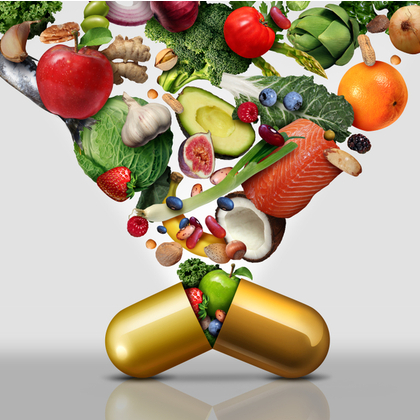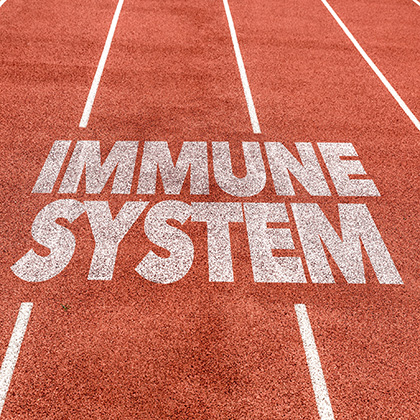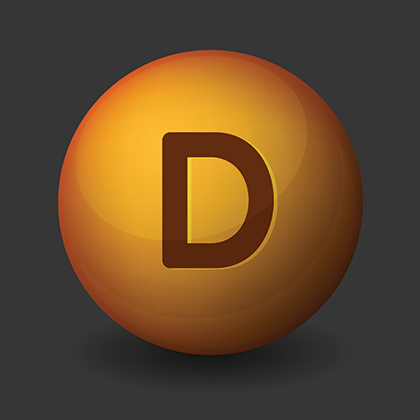
Of all the different vitamin supplements that are available, multivitamins are by far the most popular. According to a report by the Food Standards Agency, 41 per cent of people who take supplements say they currently take multivitamins while 63 per cent say they have taken them at some point (i).
There are many different multivitamin supplements available. These contain a mix of vitamins and minerals, and sometimes also other ingredients such as herbs and fatty acids. The exact combination of ingredients varies from one product to another, but a typical multivitamin contains vitamins A to K as well as minerals such as calcium, magnesium, selenium and zinc.
Is There Iron in Multivitamins?
Some – but by no means all – also contain iron. This is an important mineral because it’s a component of haemoglobin, a protein found in red blood cells. Around 70 per cent of the iron in your body is found in your haemoglobin as well as in muscle cells called myoglobin. Both work to transport oxygen around your body – haemoglobin transfers oxygen in your blood from the lungs to the tissues, while myoglobin accepts, stores, transports and releases oxygen (ii).
The Nutrient Reference Value (NRV) for iron for adults is 14mg (NRV is the daily amount of a vitamin or mineral set by the EU that the average healthy person needs to prevent deficiency) (iii). But some people need more of it than others. According to the Association of UK Dietitians (BDA) (iv):
-
Adult men need 8.7mg iron a day
-
Women aged 19 - 50 need 14.8mg iron a day
-
Women over 50 need 8.7mg a day
-
Teenage girls need 14.8mg a day, while teenage boys need 11.3mg a day
The daily requirements for children are:
0 - 3 months: 1.7mg
4 - 6 months: 4.3mg
7 - 12 months: 7.8mg
1 - 3 years: 6.9mg
4 - 6 years: 6.1mg
7 - 10 years: 8.7mg
The problem is that many people aren’t getting the iron they need in their diets. The BDA suggests that in the UK, iron intakes from food remain below these recommendations across all age groups, most notably in young children, teenage girls and women of reproductive age (v).
Not getting enough iron in your diet means your iron stores can become exhausted, which is known as iron depletion. Then if your iron stores drop even further you become at risk of developing iron-deficiency anaemia (see below).
Yet while teenage girls and premenopausal women generally have low iron intakes, these are the groups that arguably need it more than most. That’s because the most common cause of iron deficiency is blood loss caused by menstrual bleeding. In men and postmenopausal women, on the other hand, a common cause of iron deficiency is gastrointestinal blood loss (ii). People who work out a lot may also need more iron, as intense exercise may destroy red blood cells (vi).
Iron in Multivitamins
These different needs may go some way to explaining why some multivitamins contain iron while the rest are iron free. Take multivitamin products for the over 50s for example. These tend to have either no iron or a smaller amount of iron than the NRV. However, some – but not all – supplements aimed at teenagers and younger adults contain iron in amounts typically around 100 per cent of the NRV. Some multivitamins for pregnant women tend to have good levels of iron too, since pregnancy is another common cause of iron deficiency (vii).
But can you have too much iron? Unless you take a supplement your iron intake comes from your diet, and it’s unusual for anyone to get too much iron from food since the body regulates how much iron it absorbs. People who have a genetic condition called haemochromatosis are the exception to this rule, as their bodies can absorb and store far more iron than they need. Around one in 150 people is affected by haemachromatosis, and in the most severe cases the condition can cause severe problems such as organ failure (viii).
Taking 17mg or less a day of iron supplements is unlikely to cause any harm, says the NHS. But taking doses over 20mg may cause side effects such as constipation, nausea, vomiting and stomach pain (ix). Very high doses of iron can even be fatal, especially in children. So if you give your child a multivitamin supplement – especially one that’s chewable and has a pleasant taste – always make sure they’re stored out of your child’s reach.
To check whether a multivitamin supplement contains iron – and, if so, how much and what percentage that amount is of the NRV – refer to the ingredients list on the label.
Food Sources of Iron
Since your body cannot make iron you have to get it from food or nutritional supplements. Different foods contain iron in different amounts, with some types of foods richer in iron than others. The iron in animal-based foods is often called haem iron: the iron in red meat is the most easily and well absorbed, with the iron in fish and poultry also well absorbed (but not as effectively as that in red meat).
Plant-based sources of iron – called non-haem iron – are less well absorbed than animal sources. But eating haem iron alongside non-haem iron is thought to help increase the absorption of non-haem iron. If you’re following a vegetarian or vegan diet, eating foods that contain vitamin C can help with iron absorption too (this is why experts suggest drinking a glass of orange juice alongside a meal or when you take an iron supplement (x)).
Eating foods that contain copper may also be useful as copper helps improve iron absorption too: copper-rich foods include cheese, egg yolks, seafood, liver, green vegetables and dried figs. According to the NHS it’s also a good idea to drink less tea, coffee and milk and eat less dairy and foods with high levels of phytic acid (wholegrain cereals, for instance), as large amounts of these foods and drinks make it harder for your body to absorb iron (vii).
Foods rich in iron include oysters, clams, mussels, sardines, beef, lamb and pork, while vegetarian sources include fortified breakfast cereals, wheat bran, beans, lentils, nori seaweed, nuts, pumpkin seeds, eggs, dried fruit (apricots, figs, dates), blackstrap molasses and dark green leafy vegetables.
Here are some examples of how much iron can be found in 100g of common foods (xi):
| Beef (rump steak) | 3.6mg |
| Pork chop | 2.7mg |
| Chicken | 0.7mg |
| Bacon | 0.6mg |
| Tinned tuna | 1mg |
| Cod | 0.1mg |
| Mackerel | 0.8mg |
| Tofu | 1.2mg |
| Chickpeas | 2mg |
| Sesame seeds | 6.4mg |
| Peanut butter | 2.1mg |
| Sunflower seeds | 6.4mg |
| Almonds | 3mg |
| Spinach | 1.6mg |
To make sure you’re getting plenty of iron from food, choose a fortified cereal if you eat cereal for breakfast, and try to include some green, leafy vegetables with each of your main meals. Having a small snack between meals could also help – go for a palmful of nuts, seeds or dried fruit.
Iron-deficiency Anaemia: What to Look Out For
Despite the fact that iron is found in a range of foods, many of us aren’t getting enough of it for one reason or another. Indeed, iron-deficiency anaemia is common in the UK, with estimates suggesting 23 per cent of pregnant women and 14 per cent of non-pregnant women are affected (there aren’t any official figures for UK men and postmenopausal women with iron-deficiency anaemia, but worldwide it’s thought that between 2 - 5 per cent of both groups are anaemic because they’re low in iron) (xii).
If you’re low in iron, you may have lower-than-normal levels of haemoglobin, which means your body may not get the oxygen it needs to work effectively. This can cause typical anaemia symptoms including:
-
Tiredness
-
Lack of energy
-
Breathlessness
-
Heart palpitations
-
Light-headedness
-
Pale skin
-
Headaches
-
Tinnitus (ringing in the ears)
-
Tingling fingers
If you have any of the symptoms of iron-deficiency anaemia, see your GP for a diagnosis as it’s important to rule out any other underlying health issues that could be causing them. Treating anaemia is important, as if you don’t do so it can increase your risk of illness and infection (a lack of iron can affect your immune system). It can also increase your risk of developing heart or lung complications, and if you’re pregnant untreated iron-deficiency anaemia can make complications before and after the birth more likely.
The good news is treating iron-deficiency anaemia is usually straightforward, and if you’re diagnosed your GP may prescribe a course of iron tablets.
Multivitamins or Iron Supplement?
If you’ve been diagnosed with anaemia, follow your GP’s advice as to which type of supplement you should take. Iron supplements are routinely used by doctors to treat anaemia caused by iron deficiency, and are widely available with and without a prescription – though your GP may prescribe an iron tablet that’s stronger than one you can buy yourself (only take a higher dose if your GP advises it). If you decide to buy your own iron supplement, however, try to choose one that’s easy on the stomach, such as iron citrate, as some forms of iron can cause stomach upsets.
Even if you don’t have the symptoms of iron-deficiency anaemia, you may choose to take a multivitamin with iron supplement if you think you may be running low – if your diet doesn’t include much iron, for instance, and you want the convenience of taking a multivitamin too. Since there are lots of multivitamin products available, always check the label before you buy to make sure it contains iron, and in what amount (choose the appropriate product with the amount of iron that best suits your particular needs).
Find out more about iron deficiency in our guide to anaemia, visit our pharmacy health library.
References:
-
Food Standards Agency. Food Supplements Consumer Research May 2018. Available online: https://www.food.gov.uk/sites/default/files/media/document/food-supplements-full-report-final-2505018.pdf
-
University of California San Fransisco. Hemoglobin and Functions of Iron. Available online: https://www.ucsfhealth.org/education/hemoglobin-and-functions-of-iron#:~:text=Patient%20Education-,Hemoglobin%20and%20Functions%20of%20Iron,the%20lungs%20to%20the%20tissues
-
Available online: https://www.hsis.org/wp-content/uploads/2017/03/Recommended-Intake-Guidelines.pdf
-
Available online: https://www.bda.uk.com/resource/iron-rich-foods-iron-deficiency.html
-
Available online: https://www.bda.uk.com/uploads/assets/f564475a-ce9b-4e47-8da0eff74b545176/Practical-guide-nutritional-considerations-re-IRON.pdf
-
Wouthuyzen-Bakker. M., van Assen , Exercise-induced anaemia: a forgotten cause of iron deficiency anaemia in young adults. Br J Gen Pract. 2015 May;65(634):268-269. Available online: https://www.ncbi.nlm.nih.gov/pmc/articles/PMC4408516/
-
Available online: https://www.nhs.uk/conditions/iron-deficiency-anaemia/
-
Available online: https://www.haemochromatosis.org.uk/what-is-genetic-haemochromatosis
-
Available online: https://www.nhs.uk/conditions/vitamins-and-minerals/iron/
-
Available online: https://www.ouh.nhs.uk/patient-guide/leaflets/files/11903Piron.pdf
-
Available online: https://www.bda.uk.com/uploads/assets/f2abf0e1-fa59-49db-a0afb1cb1bf9a878/Iron-food-fact-sheet.pdf
-
Available online: https://cks.nice.org.uk/anaemia-iron-deficiency#!backgroundSub:2
Related Posts
Disclaimer: The information presented by Nature's Best is for informational purposes only. It is based on scientific studies (human, animal, or in vitro), clinical experience, or traditional usage as cited in each article. The results reported may not necessarily occur in all individuals. Self-treatment is not recommended for life-threatening conditions that require medical treatment under a doctor's care. For many of the conditions discussed, treatment with prescription or over the counter medication is also available. Consult your doctor, practitioner, and/or pharmacist for any health problem and before using any supplements or before making any changes in prescribed medications.

Christine
Christine Morgan has been a freelance health and wellbeing journalist for almost 20 years, having written for numerous publications including the Daily Mirror, S Magazine, Top Sante, Healthy, Woman & Home, Zest, Allergy, Healthy Times and Pregnancy & Birth; she has also edited several titles such as Women’ Health, Shine’s Real Health & Beauty and All About Health.
View More



